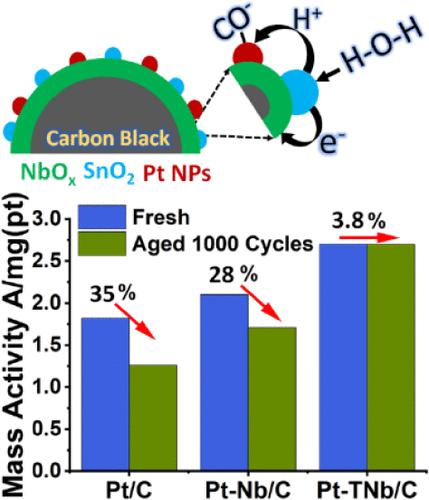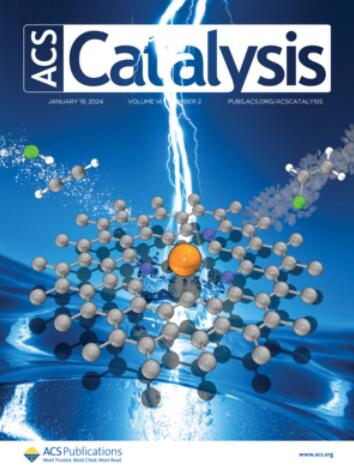Tuning Vacancy in Metal Oxide Support to Enhance Activity and Durability of Pt Catalysts for the Methanol Oxidation Reaction
IF 11.3
1区 化学
Q1 CHEMISTRY, PHYSICAL
引用次数: 0
Abstract
Coupling Pt with metal oxides has been shown to be an effective approach for catalyst durability enhancement in the methanol oxidation reaction (MOR). Here, we report tuning valence in niobium oxide (NbOx) as a support by tin oxide (SnO2) as a promoter to mediate the Pt electrocatalysis in MOR. The catalyst was designed to consist of Pt supported on SnO2-modified NbOx coated on carbon black (Pt-TNb/C), which shows significantly enhanced electrochemical durability and activity in MOR that are better than the catalyst without SnO2 modification (Pt-Nb/C) and those reported in the literature. Electron diffraction pair distribution function analysis showed an increase in the Nb–Nb bond length after SnO2 incorporation, from 3.80 to 3.84 Å, indicative of a tuning effect. X-ray photoelectron spectroscopy further confirmed valence mediation in the Pt-TNb/C catalyst, as evidenced by the positive binding energy peak shifts of 0.49 and 0.66 eV in Nb 3d5/2 and Nb 3d3/2, respectively, as compared to those of the Pt-Nb/C catalyst. The Pt-Nb/C catalyst has MOR peak currents of 2.71 A/mg-Pt at the beginning and 1.94 A/mg-Pt at the end of 1000 cycles in 1.0 M methanol in 0.5 M H2SO4 electrolyte, corresponding to a 28.41% activity loss. However, the Pt-TNb/C catalyst with SnO2 tuning has a much smaller loss at only 3.77%, with MOR peak currents of 3.45 A/mg of Pt at the beginning and 3.32 A/mg of Pt at the end under the same test conditions. The high durability and activity of the new catalyst are attributed to the effect of valence tuning of the niobium oxide, in addition to a bifunctional effect from tin oxide.

求助全文
约1分钟内获得全文
求助全文
来源期刊

ACS Catalysis
CHEMISTRY, PHYSICAL-
CiteScore
20.80
自引率
6.20%
发文量
1253
审稿时长
1.5 months
期刊介绍:
ACS Catalysis is an esteemed journal that publishes original research in the fields of heterogeneous catalysis, molecular catalysis, and biocatalysis. It offers broad coverage across diverse areas such as life sciences, organometallics and synthesis, photochemistry and electrochemistry, drug discovery and synthesis, materials science, environmental protection, polymer discovery and synthesis, and energy and fuels.
The scope of the journal is to showcase innovative work in various aspects of catalysis. This includes new reactions and novel synthetic approaches utilizing known catalysts, the discovery or modification of new catalysts, elucidation of catalytic mechanisms through cutting-edge investigations, practical enhancements of existing processes, as well as conceptual advances in the field. Contributions to ACS Catalysis can encompass both experimental and theoretical research focused on catalytic molecules, macromolecules, and materials that exhibit catalytic turnover.
 求助内容:
求助内容: 应助结果提醒方式:
应助结果提醒方式:


